Kindle Notes & Highlights
Read between
December 14 - December 26, 2019
Some instructors have suggested that a research paper should have about as many items in its working bibliography (the list of works actually cited in the paper) as it has pages of text.
This is only a general guideline, however, and it may not apply to papers shorter than ten pages.
At least one of the bibliographies consulted should be less than ten years old; otherwise many of the works listed will be outdated.
For example, textweek.com maintains an excellent bibliography with links to online articles.
One kind of source that too many exegetes avoid is the work of the great exegetes and preachers of the past—Chrysostom, Augustine, Luther, Wesley, and others. Their literary and theological insights are neglected only to our own detriment. These can be very illuminating sources.
Avoid, for instance, a passage that is so emotionally difficult for you, for whatever reason, that your paper is liable to become more of an exegesis of your psychological state or personal history than of the text itself.
Remember once again: an exegesis paper without a thesis is not really an exegesis, a reading of the text.
a brief summary and/or outline of the entire book is included in the paper, it should appear in the previous section on literary context, not this section.
A superior exegesis sheds unique light on a biblical text because the exegesis is the result of one’s own personal engagement with the text. Such an exegesis is really an expression of the unique intersection of contexts—those of the author, the original readers, and the interpreter. If you apply yourself to the study of the Bible, always keeping an eye on its various contexts—as well as your own—you may well be surprised at what you discover.


